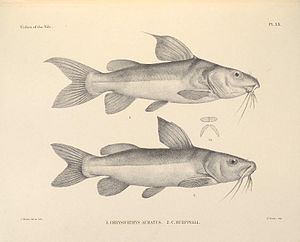Chrysichthys
| Chrysichthys | ||||||||||||
|---|---|---|---|---|---|---|---|---|---|---|---|---|

Chrysichthys auratus (above) and Chrysichthys rueppelli , drawing from The fishes of the Nile by George Albert Boulenger . |
||||||||||||
| Systematics | ||||||||||||
|
||||||||||||
| Scientific name | ||||||||||||
| Chrysichthys | ||||||||||||
| Bleeker , 1809 |
Chrysichthys is a genus of African catfish from the Claroteidae family. The fish are found in West and Central Africa, in the Nile , in the Congo Basin , Lake Tanganyika and in Mozambique .
features
Chrysichthys species are 8 cm to 1.5 m long. You have four pairs of barbels . The head is four to six times longer than it is high. The eyes are large and are on the sides of the head.
Their in most cases relatively high dorsal fin is supported by six, less often five or seven soft rays, which protrude a very short fin spine, followed by a strong, well developed fin spine. The second, large fin spine is slightly serrated at the rear edge. The adipose fin is small to medium in size and never ossified, its base is shorter than the length of the head. The pectoral fins have a serrated fin spine and eight to eleven branched fin rays. The ventral fins located in the middle of the body have a fin spine and five fin rays. The medium-sized anal fin has three to four hard rays and 6 to 12 soft rays. The caudal fin is deeply forked.
Dimorphism
In the Chrysichthys species there is a striking dimorphism between sexually mature and not yet sexually mature males. In sexually mature males, the head becomes wider and the skin and the mucous layer that protects it thicker. The spines of the pectoral and dorsal fin become stronger and less needle-like. In many cases the nasal barbels become longer and the teeth of the palatine bone develop more strongly. This dimorphism occurs particularly strongly in the subgenus Chrysichthys and Melanodactylus , where the jaw teeth are also stronger.
The dimorphism is so pronounced that sexually mature males have been described as separate species, e.g. B. those of C. nigrodigitatus as C. furcatus or males of C. auratus as C. persimilis and C. rueppelli .
species
- Chrysichthys acsiorum Hardman, 2008
- Chrysichthys ansorgii Boulenger , 1910
- Chrysichthys bocagii Boulenger, 1910
- Chrysichthys brachynema Boulenger, 1900
- Chrysichthys cranchii (Leach, 1818)
- Chrysichthys delhezi Boulenger, 1899
- Chrysichthys duttoni Boulenger, 1905
- Chrysichthys habereri Steindachner, 1912
- Chrysichthys helicophagus Roberts & Stewart, 1976
- Chrysichthys laticeps Pellegrin , 1932
- Chrysichthys levequei Risch, 1988
- Chrysichthys longibarbis (Boulenger, 1899)
- Chrysichthys longipinnis (Boulenger, 1899)
- Chrysichthys mabusi Boulenger, 1905
- Chrysichthys macropterus Boulenger, 1920
- Chrysichthys maurus ( Valenciennes , 1840)
- Chrysichthys okae Fowler , 1949
- Chrysichthys ornatus Boulenger, 1902
- Chrysichthys polli Risch, 1987
- Chrysichthys punctatus Boulenger, 1899
- Chrysichthys sharpii Boulenger, 1901
- Chrysichthys teugelsi Risch, 1987
- Chrysichthys thonneri Steindachner, 1912
- Chrysichthys turkana Hardman, 2008
- Chrysichthys uniformis Pellegrin, 1922
- Chrysichthys wagenaari Boulenger, 1899
- Chrysichthys walkeri Günther, 1899
- Subgenus Chrysichthys Bleeker, 1858
- Chrysichthys auratus (Geoffroy Saint-Hilaire, 1809)
- Subgenus Chrysobagrus Boulenger, 1899 ; southeastern Nigeria, Gabon, Congo Basin, Mozambique.
- Chrysichthys brevibarbis (Boulenger, 1899)
- Chrysichthys longidorsalis Risch & Thys van den Audenaerde, 1981
- Chrysichthys nyongensis Risch & Thys van den Audenaerde, 1985
- Subgenus Melanodactylus Bleeker, 1858 ; West Africa and West Central Africa.
- Chrysichthys dageti Risch, 1992
- Chrysichthys johnelsi Daget, 1959
- Chrysichthys nigrodigitatus ( Lacépède , 1803)
- Chrysichthys ogooensis (Pellegrin, 1900)
- Subgenus Rheoglanis Poll, 1966 ; West Africa and West Central Africa.
- Chrysichthys aluuensis Risch, 1985
- Chrysichthys dendrophorus (Poll, 1966)
- Chrysichthys hildae Bell-Cross, 1973
- Chrysichthys thysi Risch, 1985
literature
- Melanie Stiassny, Guy Teugels & Carl D. Hopkins: The Fresh and Brackish Water Fishes of Lower Guinea, West-Central Africa. Volume 1. ISBN 9789074752206
Web links
- Chrysichthys on Fishbase.org (English)